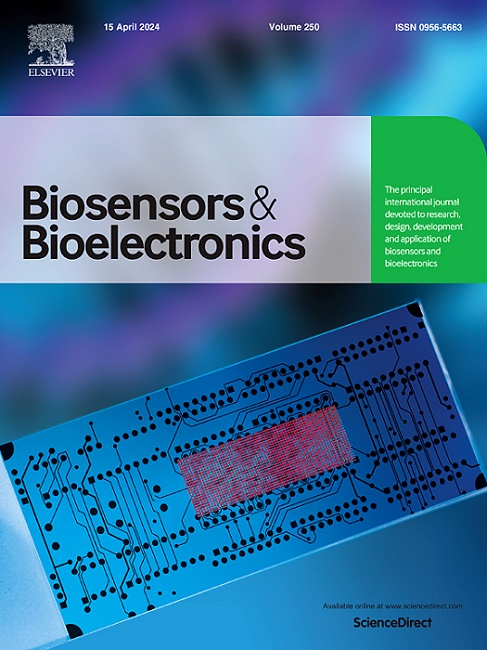Ultrasensitive detection of tetracycline using the disruption of crosslink-enhanced emission and inner-filter effect-induced phosphorescence quenching of carbonized polymer dots
IF 10.7
1区 生物学
Q1 BIOPHYSICS
引用次数: 0
Abstract
Accumulation of tetracycline (TC) in the environment and food may lead to potential health risks and the emergence of antibiotic-resistant bacteria. To meet the demand for sensitivity, ease of use, and portability in detecting TCs, we fabricated a green phosphorescent film consisting of crosslinked polymer-integrated carbon dots (named carbonized polymer dots, CPD) and polyvinyl alcohol (PVA) polymers for ultrasensitive sensing of TCs via the inner filter effect-mediated phosphorescence quenching and the disruption of the crosslink-enhanced emission (CEE) effect by TC. To create polymer structures on the carbon dots for interaction with PVA, CPDs were synthesized via low-temperature hydrothermal treatment using citric acid and cysteine. Compared to products with oxidized sulfur or no sulfur doping, the incorporation of nitrogen and sulfur in CPDs was found to effectively facilitate intersystem crossing, significantly enhancing phosphorescence. By measuring the phosphorescence properties of compounds inside and outside the dialysis bag at different dialysis times, we confirmed that crosslinking interactions between CPD and PVA polymers can create a rigid environment to amplify the phosphorescence of sub-luminophores (e.g., hydroxyl, carboxyl, and amino groups) through the CEE effect. These features make the CPD/PVA film an effective tool for phosphorescence turn-off detection of TC, offering a wide linear detection range (1 nM–1 mM), a low limit of detection (0.7 nM), and good selectivity over potential interfering substances, such as metal ions, amino acids, fatty acids, and lactose. Our finding indicates that the TC-triggered phosphorescence quenching of the CPD/PVA film originates from TC-mediated IFE effect and TC-disrupted CEE effect. The CPD/PVA film was shown to establish a linear calibration curve to quantify TC in drinking water and milk samples with good recoveries (84 %–120 %).

求助全文
约1分钟内获得全文
求助全文
来源期刊

Biosensors and Bioelectronics
工程技术-电化学
CiteScore
20.80
自引率
7.10%
发文量
1006
审稿时长
29 days
期刊介绍:
Biosensors & Bioelectronics, along with its open access companion journal Biosensors & Bioelectronics: X, is the leading international publication in the field of biosensors and bioelectronics. It covers research, design, development, and application of biosensors, which are analytical devices incorporating biological materials with physicochemical transducers. These devices, including sensors, DNA chips, electronic noses, and lab-on-a-chip, produce digital signals proportional to specific analytes. Examples include immunosensors and enzyme-based biosensors, applied in various fields such as medicine, environmental monitoring, and food industry. The journal also focuses on molecular and supramolecular structures for enhancing device performance.
 求助内容:
求助内容: 应助结果提醒方式:
应助结果提醒方式:


